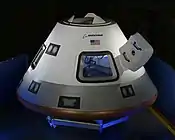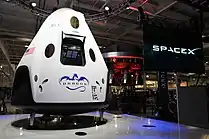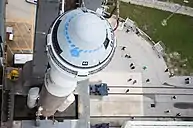商業載人航天發展計畫
商業載人航天發展計畫(英語:,縮寫:)始於商業載人發展(CCDev)計劃的第二輪,該計劃從用於人類航天的技術開發計劃擴展到一個競爭性開發計劃,該計劃將生產可在商業載人計劃中使用的航天器 。從2011年開始,NASA以從私人供應商那裡購買載人太空船的概念,以載運美國和各國的太空人往返國際太空站(ISS)。2014年9月,SpaceX和波音公司獲得了發射太空人升空的運營合同。[1]
兩公司都在2019年進行了一次無人的測試飛行。SpaceX載人龍飛船示範1號的Dragon 2於2019年3月到達國際太空站,並通過海面濺落於大西洋返回地球。由於任務經過時間異常,波音星際航線的軌道飛行測試未能在2019年12月到達太空站,但完成了一些測試目標並執行了安全氣囊著陸。因此,波音和NASA已同意在2021年3月重新執行軌道飛行測試(OFT)任務。
在示範飛行完成之前,兩家公司均已簽約向國際太空站提供六次飛行任務。[2]第一批太空人於2018年8月3日宣布。[3]預計兩家公司將從2020年5月由SpaceX率先開始從美國發射太空人升空,但是在2020年4月6日,波音公司宣布將重做其軌道飛行測試,這意味著載人飛行測試將在2021年發射。
任務
| 任務 | 圖章 | 太空船 | 描述 | 乘員 | 日期 | 結果 |
|---|---|---|---|---|---|---|
| 龙飞船2号 天龍號太空船C201 (1) |
Pad abort test, Cape Canaveral Air Force Station, Florida | 不適用 | 2015年5月6日 | 成功 | ||
| 龙飞船2号 載人龍飛船C204 (1) |
Uncrewed test flight. DM-1 launched on 2 March 2019 and docked to ISS PMA-2/IDA-2 docking port a little under 24 hours after launch. The Dragon spent five days docked to ISS before undocking and landing on 8 March 2019. | None | 2019年3月2日[4] | 成功 | ||
Boeing Pad Abort Test |
波音星际航线 Spacecraft 1 |
Uncrewed Pad Abort Test | 不適用 | 2019年11月4日 | 成功 | |
波音軌道飛行測試 |
波音星际航线 Spacecraft 3 Calypso |
Uncrewed test flight. Was the first flight of an Atlas V with a dual engine Centaur upper stage. Was originally planned to spend eight days docked to ISS before landing. However, Starliner was unable to rendezvous with the station due to the MET anomaly forcing it to enter a lower-than-expected orbit.[5] The spacecraft returned on 22 December 2019 after spending two days in orbit. OFT-2 was proposed to meet all objectives. | None | 2019年12月20日[6] | 部分失败 due to MET anomaly | |
| 龙飞船2号 C205 (1) |
A Falcon 9 booster launched a Dragon 2 capsule from LC-39A to perform an in-flight abort shortly after Max q in order to test Dragon 2's launch abort system. Abort occurred at 84 seconds after launch and Dragon 2 successfully separated from the Falcon 9 and flew away using its SuperDraco thrusters. The Falcon 9 booster disintegrated as a result of aerodynamic forces. Dragon 2 splashed down nine minutes after launch after successfully deploying its four parachutes. | 不適用 | 2020年1月19日 | 成功 | ||
載人龍飛船示範2號 |
 |
龙飞船2号 奮進號 (1) |
Crewed test flight. Dragon 2 launched with two crew members and dock to the ISS about 18 hours later. Dragon and its crew spent up to 62 days on board the ISS.[7] | 2020年5月30日 | 成功 | |
| 波音星际航线 Spacecraft 2 |
Uncrewed test flight. Suggested by Boeing and approved by NASA on July 30,2021 at 2:53 p.m. EDT due to the partial failure of software on the previous Starliner test flight, in particular its failure to reach or dock with the ISS. | 不適用 | 2022年5月19日[8] | 成功 | ||
| 波音星际航线 | Extended crewed test flight. | NET 2022第三季度[9] | 计划 |
參見
- 2010年NASA授權法案
- 商業載人計劃
參考資料
- Bolden, Charlie. . NASA.gov. [September 16, 2014]. (原始内容存档于2020-11-11).
- . [2021-01-03]. (原始内容存档于2020-10-20).
- . NASA. August 3, 2018 [2021-01-03]. (原始内容存档于2020-03-20).
- . blogs.nasa.gov. [2019-02-22]. (原始内容存档于2020-10-23) (美国英语).
- Bridenstine, Jim. . @JimBridenstine. 2019-12-20 [2019-12-20]. (原始内容存档于2019-12-20) (英语).
- Foust, Jeff. . Spacenews. [9 October 2019].
- . [2021-01-03]. (原始内容存档于2020-04-24).
- . Space Coast Daily. 21 July 2021 [22 July 2021]. (原始内容存档于2021-07-22).
- Clark, Stephen. . [2020-09-03]. (原始内容存档于2020-10-23) (美国英语).
外部連結
- Official NASA Commercial Crew Program page(页面存档备份,存于)
- Official NASA Press Kit relating to the Commercial Crew Program(页面存档备份,存于)
- Commercial Crew & Cargo Document Library on NASA.gov(页面存档备份,存于)
- CCDev 1 Space Act agreements(页面存档备份,存于)
- Partners Mature Spacecraft Designs(页面存档备份,存于), NASA video update, 14 January 2014.
- Boeing CCtCap Contract (redacted)(页面存档备份,存于)
- SpaceX CCtCap Contract (redacted)(页面存档备份,存于)
This article is issued from Wikipedia. The text is licensed under Creative Commons - Attribution - Sharealike. Additional terms may apply for the media files.



